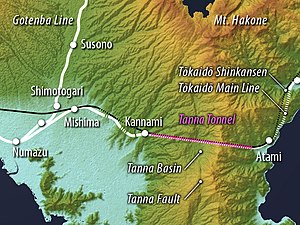Tanna tunnel
| Tanna tunnel | |
|---|---|
|
West portal of the Tanna Tunnel
|
|
| use | Railway tunnel |
| traffic connection | Main Tōkaidō line |
| place | Izu Peninsula |
| length | 7804 m |
| Number of tubes | 1 |
| construction | |
| Client | Ministry of Railways |
| start of building | March 21, 1918 |
| completion | June 19, 1933 |
| planner | Kajima |
| business | |
| operator | JR Central |
| release | December 1, 1934 |
| map | |

|
|
| Coordinates | |
| East portal | 35 ° 5 '56 " N , 139 ° 3' 44" E |
| West portal | 35 ° 6 ′ 30 " N , 138 ° 58 ′ 37" E |
The Tanna Tunnel ( Japanese 丹 那 ト ン ネ ル ; Tanna tonneru ) is a railway tunnel on the Japanese island of Honshū . It is located in Shizuoka Prefecture on the JR Central operated Tōkaidō Main Line , one of the country's most important railway lines. The double-track tunnel is 7.804 km long and connects Atami with Kannami . It leads on the northern edge of the Izu Peninsula through tectonically unstable extensions of the Taga volcano with several faults . After 16 years of construction, it was opened on December 1, 1934.
The Shin Tanna Tunnel, opened in 1964 on the Tōkaidō-Shinkansen high-speed line , runs parallel to this .
history
The original route of the Tōkaidō main line , completed in 1889, bypassed the Hakone volcanic massif on its north side. From Kōzu it led first northwest via Matsuda to Gotemba and then south to Numazu . It corresponds to today's Gotemba line and increasingly turned out to be a bottleneck for traffic between the metropolises of Tokyo and Osaka . The apex is at 455 m TP and the route was often interrupted due to landslides. Because of the up to 25 ‰ steep inclines, additional push locomotives had to be used. From 1912 mallet locomotives were in use, but they could only increase the transport performance slightly.
For these reasons, the Ministry of Railways decided to build a significantly flatter new line from Kōzu via Atami and Mishima to Numazu. At its heart is the Tanna tunnel between Atami and Kannami , named after the Tanna- fault on the northern edge of the Izu Peninsula . The tunnel had to be driven through the tectonically unstable foothills of the Taga volcano, which consist mainly of andesite and basalt and are criss-crossed by thin layers of sediment . In addition, there are loose layers of volcanic ash , soaked with groundwater . The construction company Kajima expected a construction time of seven years, the government hoped that this project would stimulate the economy in the face of an impending post-war recession.
The groundbreaking took place on March 21, 1918 in Atami, and a little later the drilling was also carried out from Kannami. From the start, engineers and workers had to deal with numerous unforeseen problems. This included regular earthquakes, soft rock formations, hot water springs, and especially large amounts of seeping water. On April 1, 1920, a 270 m long section of the tunnel collapsed and trapped 42 workers. 17 of them were rescued after a week by drilling a rescue tunnel. The Great Kanto earthquake on September 1, 1923 caused severe damage. Another collapse occurred on November 26, 1930 as a result of the North Izu earthquake, killing five workers. The part of the tunnel to the east of the affected fault shifted two meters to the north. For this reason, the Tanna tunnel is slightly curved instead of the straight line as planned
Completion of the tunnel was delayed by over nine years and the cost was more than two and a half times the original estimate. A total of 67 people lost their lives while building the tunnel. Robert Ridgway, the chief engineer of the New York City Subway , visited the construction site in 1930 and said that nowhere in the world is there a difficult tunnel to build and that the courage of the Japanese workers is admirable. He criticized that most of the problems were due to the engineers failing to conduct geological surveys. The breakthrough came on June 19, 1933, with Railway Minister Mitsuchi Chūzō triggering the last explosive charge. On March 10, 1934, the ministry announced the completion of the tunnel work, whereupon the tracks were laid and the catenary tensioned. The first train passed the tunnel on December 1, 1934
The new line was electrified from the start. The Ministry of Railways was initially responsible for the operation, from 1949 the Japanese State Railways . In 1964, the Shin Tanna Tunnel was opened, which runs parallel about 50 meters north of it and in which the tracks of the high-speed Tōkaidō Shinkansen are laid. Since the privatization of the state railways in 1987, JR East has been carrying out passenger and JR Freight transporting goods.
See also
Web links
literature
- Yoshimura Hisashi (Ed.): ト ン ネ ル も の が た り - 技術 の 歩 み . Sankaido, Tokyo 2002, ISBN 978-4-381-01437-5 .
Individual evidence
- ↑ Yoshinobu Oikawa: 鉄 道 . Tōkyō-dō shuppan, Chiyoda 1996, ISBN 978-4-490-20290-8 , pp. 241 .
- ↑ Hisashi Kuno: Geology of the New Tanna Tunnel, Shin-Tokaido Line . Ed .: Journal of the Japan Society of Engineering Geology. Tokyo 1964, p. 31-41 , doi : 10.5110 / jjseg.5.31 .
- ↑ Shigeru Onoda: A History of Railway Tunnels in Japan. (PDF, 2.8 MB) In: Breakthrough in Japanese Railways 14th East Japan Railway Culture Foundation, October 2015, pp. 40–41 , archived from the original on July 31, 2018 ; accessed on December 1, 2018 (English).

